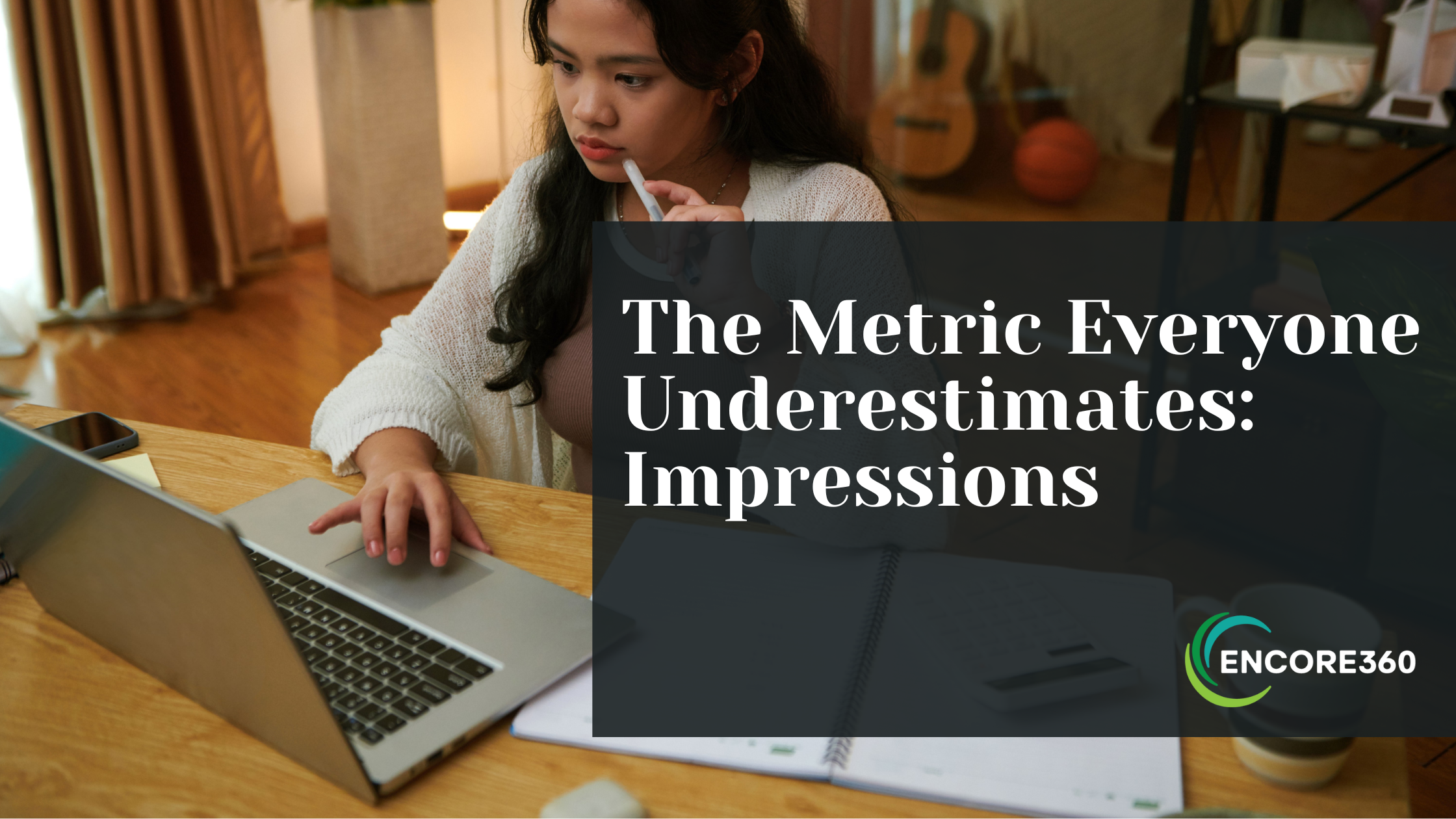Clicks are overrated.
Let’s say that louder for the marketers in the back: Clicks are not the metric that matters most.
Sure, they’re easy to measure. They make dashboards look busy. But in a media-driven marketing model, what really matters is impressions — and more specifically, impressions with impact.
Because before you can get someone to click, subscribe, or buy, you have to get them to notice. To think. To feel something. And that begins with reach, resonance, and recall, not raw traffic.
What Media Companies Already Know About Attention
Media professionals understand something most marketers forget: the majority of content consumption is passive.
- People scroll past headlines
- They skim posts without clicking
- They read a newsletter preview but never open it
- They absorb your content ambiently, through repetition, exposure, and memory
And guess what? That still builds brand.
When done right, impression-rich content teaches before the click, delivers insight at a glance, and reinforces your voice repeatedly. It primes trust before action is needed.
This is how you create what brand scientists call “mental availability” — the probability that someone thinks of your brand in a buying moment. You’re not trying to go viral. You’re earning memorability.
Why This Matters Now
The rules of digital discovery have changed. These days, people skim summaries, rely on AI, and consume more content passively than ever before.
AI tools like ChatGPT, Perplexity, and Google’s evolving Search Generative Experience (SGE) don’t drive traffic in the traditional sense. They summarize, extract, and recommend based on trust and clarity, not keyword tricks or curiosity-bait.
Your best content might never be clicked at all. A single sentence from your article might show up in an AI snippet. A stat from your newsletter might anchor a summary. The whole point is to become recognizable, whether someone clicks through or not.
Value travels without the click.
The Zero-Click Content Strategy
Zero-click content is content that delivers value without requiring the user to leave the platform.
In traditional marketing, this sounds like failure: “But they didn’t convert!”
In media marketing, it’s trust-building: “They learned something. They remembered us. They’ll be back.”
Here’s what happens when you embrace zero-click content:
- You earn attention by being generous
- You create mental availability
- You become a known entity before they ever click
And when they do need what you offer, they don’t Google the category. They search for you.
Five Zero-Click Formats That Work
1. The Single-Slide Visual Explainer
One image, one core idea. A diagram showing how your product fits into a facility’s workflow: no link needed. Make it scannable, branded, and shareable. Great diagrams earn screenshots, get shared on Slack, and are overall remembered.
2. The Teaching Thread
Five to ten posts that unpack a core insight on LinkedIn or X. Example: “7 things your procurement team actually wants to know before a system install.” No links. Just value. The reader stays on the platform. The insight builds trust. The voice builds familiarity.
3. The Executive POV Post
A first-person mini-essay (150–300 words) on LinkedIn. Example: “One thing I learned this week running sales for a water tech company.” Direct, insightful, no CTA needed. This builds leadership visibility and adds humanity to the brand.
4. Contextual Quote Cards
A branded visual with an original insight. Example: “Backflow prevention isn’t just a safety issue. It’s a municipal trust issue.” Quotes are fast to read, fast to share, and packed with subtext. A good quote card says: We know what we’re talking about and we’re not afraid to say it clearly.
5. The Micro-FAQ
One question, one answer, 2–3 paragraphs max. Example: “Why does UV degradation matter in high-altitude installs?” Answer it completely. Don’t tease it. No click required. This anticipates buyer questions and builds “they get me” energy.
Metrics That Actually Matter
Most marketing dashboards are built around lead gen metrics: CTR, bounce rate, and form fills. That’s fine, those still matter. But they’re not enough.
Media brands measure differently. Here are some examples of what they might track:
| Metric | Why It Matters |
| Impressions | Top-of-funnel awareness |
| Post Saves | Indicates long-term utility |
| Direct Traffic Lift | Sign of off-platform brand recall |
| Brand Mentions | Tracks share of voice in-market |
| Average Watch Time | Proves content is holding attention |
| Comment Quality | Engagement depth, not just volume |
However, the ultimate signal is reusability.
Are other teams pulling from this content to use elsewhere? Sales decks, onboarding materials, customer FAQs? The first time a sales rep asks for the link to a recent blog post, you’ll know you’ve done it right.
When your content shows up in meetings you’re not in — when a prospect references your post before your account executive brings it up — that’s when you know it’s working.
Making the Shift: Three Action Steps
Ready to move from clicks to impressions? Here’s where to start:
1. Audit your last 10 posts. How many required a click to get value? Rewrite three of them to teach in-stream. Give away the insight right there in the feed.
2. Pick two new visibility metrics. Start tracking impressions and post saves. These tell you if your content is working beyond clicks.
3. Create one zero-click series. Launch a weekly insight that delivers value where your audience already is. Make it recognizable, useful, and consistent.
The Real Goal: Build Recognition
You don’t need more clicks. You need more recognition.
The best B2B brands aren’t just clicked. They’re remembered, respected, and referenced.
And that all starts long before someone ever fills out a form.
Stop positioning content around the click. Instead, optimize for the moment someone says, “I read something from them about this.”
Create content that doesn’t ask for attention, but earns it.
